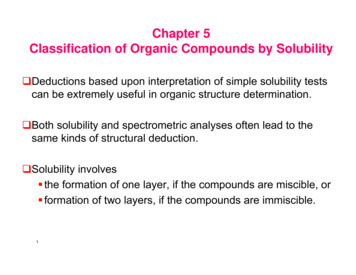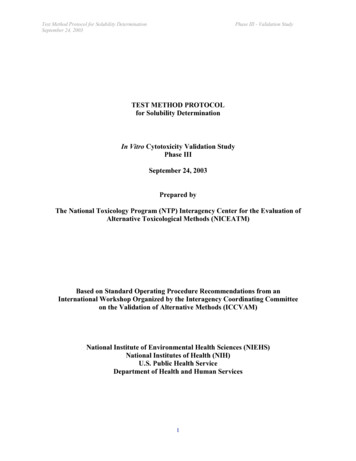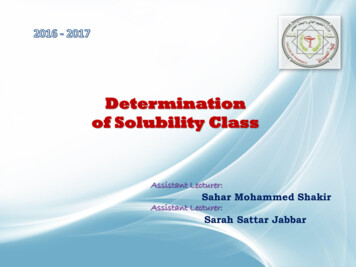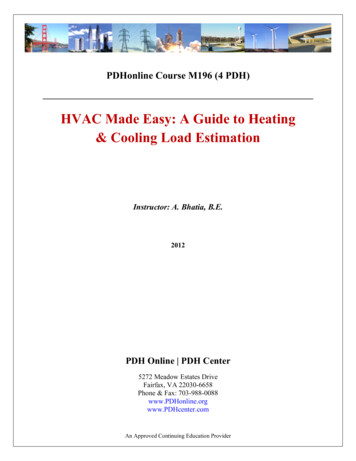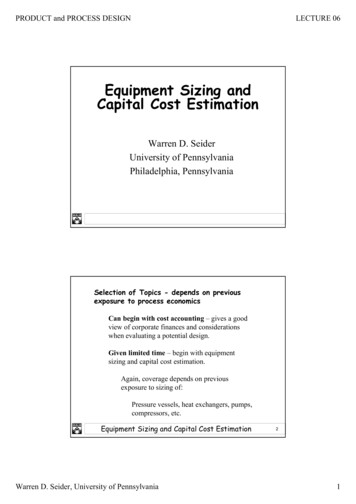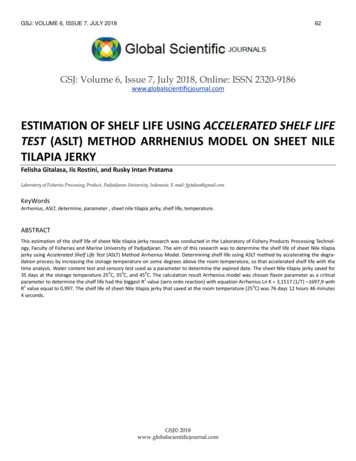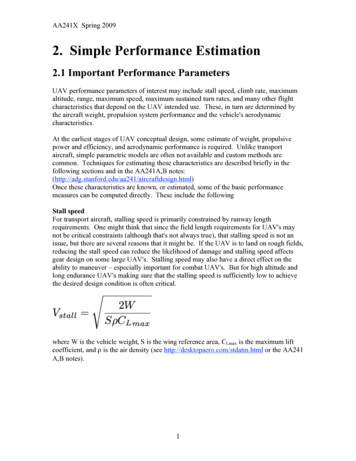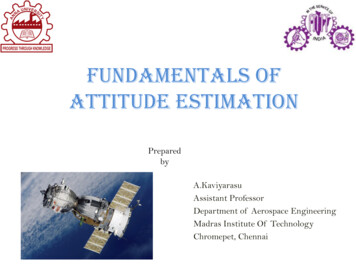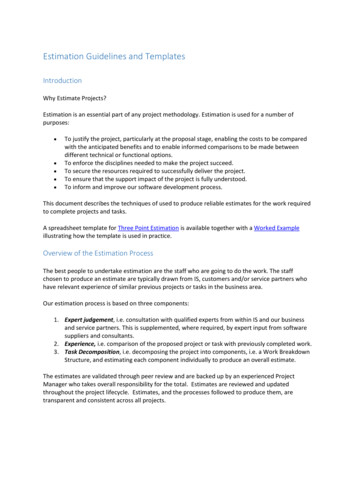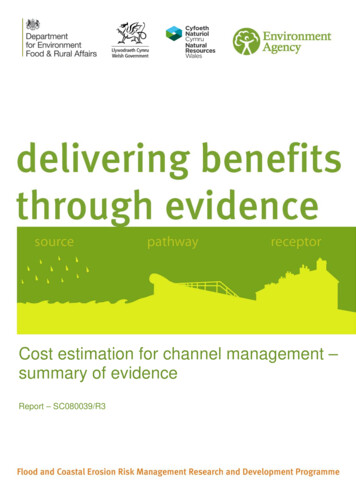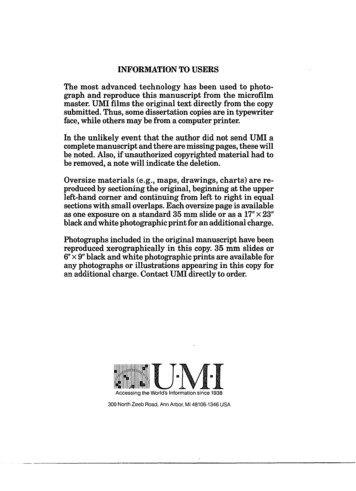
Transcription
INFORMATION TO USERSThe most advanced technology has been used to photograph and reproduce this manuscript from the microfilmmaster. UMI films the original text directly from the copysubmitted. Thus, some dissertation copies are in typewriterface, while others may be from a computer printer.In the unlikely event that the author did not send UMI acomplete manuscript and there are missing pages, these willbe noted. Also, if unauthorized copyrighted material had tobe removed, a note will indicate the deletion.Oversize materials (e.g., maps, drawings, charts) are reproduced by sectioning the original, beginning at the upperleft-hand corner and continuing from left to right in equalsections with small overlaps. Eactt oversize page is availableas one exposure on a standard 35 mm slide or as a 17" x 23"black and white photographic print for an additional charge.Photographs included in the original manuscript have beenreproduced xerographically in this copy. 35 mm slides or6" x 9" black and white photographic prints are available forany photographs or illustrations appearing in this copy foran additional charge. Contact UMI directly to order.IAccessing the World's Information since 1938300 North Zeeb Road, Ann Arbor, M148106-1346 USA
Order Number 8822433. t.imationof aqueous solubility of organic compoundsPinal-Calvillo, Rodolfo, Ph.D.The University of Arizona, 1988U·M·I300 N. Zeeb Rd.Arm Arbor, MI 48106
PLEASE NOTE:In all cases this material has been filmed in the best possible way from the available copy.Problems encountered with this document have been identified here with a check mark "; .1.Glossy photographs or pages2.Colored illustrations, paper or print3.Photographs with dark background4.Illustrations are poor copy5.Pages with black marks, not original copy s.Print shows through as there is tt;!xt on both sides of page7.Indistinct, broken or small print on several pages8.Print exceeds margin requirements9.Tightly bound copy with print lost in spine./10.Computer printout pages with indistinct print11.Page(s)author.lacking when material received, and not available from school or12.Page(s)seem to be missing in numbering only as text follows.13.Two pages numbered14.Curling and wrinkled pages15.Dissertation contains pages with print at a slant, filmed as received16.Other. Text follows.U·M-I
1ESTIMATION OF AQUEOUS SOLUBILITY OFORGANIC COMPOUNDSbyRodolfo Pinal-CalvilloA Dissertation Submitted to the Faculty of theDEPARTMENT OF PHARMACEUTICAL SCIENCESIn Partital Fulfillment of the RequirementsFor the Degree ofDOCTOR OF PHILOSOPHYWITH A MAJOR IN PHARMACEUTICAL SCIENCESIn the Graduate CollegeTHE UNIVERSITY OF ARIZONA1 9 8 8
THE UNIVERSITY OF ARIZONAGRADUATE COLLEGE2As members of the Final Examination Committee, we certify that we have readthedi sertationentitledRodo1fo Pinal Calvilloprepared byEstimation of aqueous solubility of organic compoundsand recanmend that it be accepted as fulfilling the dissertation requirementfor the Degree of Sctmue1 )J/Ya1kowskyDoctor of Philosophy-"\Nj Od f- o WALQo e 4L19L88Date4/19/88Date4/19/88Date c. 1i1}/ 4/19/88Date4/19/88DateHichae1 F. BurkeFinal approval and acceptance of this dissertation is contingent upon thecandidate's submission of the final copy of the dissertation to the GraduateCollege.I hereby certify that I have read this dissertation prepared under mydirection and recommend that it be accepted as fulfilling the torSamuel/I. Ya1kowskyDate
3STATEMENT BY AUTHORThis dissertation has been submitted in partialfulfillment of the requirements for an advanced degree atthe University of Arizona and is deposited in the UniversityLibrary to be made available to borrowers under rules of theLibrary.Briefquotationsfrom thisdissertationareallowable without special permission, provided that accurateacknowledgment of source is made. Requests for permissionforextended quotation from or reproduction ofthismanuscript in whole or in part may be granted by the head ofthe major department or the Dean of the Graduate Collegewhen in his or her judgement the proposed use of thematerial is in the interest of scholarship. In all otherinstances, however, permission must be obtained from theauthor.SIGNED:----- ------------------- :::
4DEDICATIONTo God
5ACKNOWLEDGMENTI wish to thank Dr. Yalkowsky for his guidance andinterest in my advancement. I want to use this opportunityto express my appreciation and respect to him asascientist, as my advisor, and as a person.I also wish to thank Ms. Rose-Marie Dannenfelser forher invaluable help and friendship throughout these years.
6TABLE OF CONTENTSLIST OF ILLUSTRATIONS . . . . . . .8LIST OF TABLES . . .10ABS TRACT12 . . . . . . 1. INTRODUCTIONTheoretical ConsiderationsIdeal Systems . . . . . . . . . . . . . . . . . . . . . . . . . . . . . . . . . . . .Ideal Solubility - Crystallinity . .Ideal Solubility of Liquids . .Ideal Mixing . . .2. REAL SYSTEMSCrystall ini ty151617222327Mixing . . . . . . . . . . . . . . . . . . . . . . . . . . . . . . . . . . . . . . . . . . .28Activity Coefficients . . . . .Excess Quantities and Activity Coefficients . .Gibbs Energy of Mixing and Partial MiscibilitySolutions and Activity CoefficientsRegular Solutions . . . . . .Athermal Solutions . .Local Composition . . . .Solut ions of Groups . .UNIQUAC . .2930323. AQUEOUS SOLUTIONSEstimation of Aqueous Solubility . .Molecular Volume . .Molecular Surface Area . . . .Boiling Point . . . . . . . . . . . . . . . . . . . . . . . . . . . . . . . . .Molecular Connectivity . . . . . .Parachor . .Octanol-water Partition Coefficient . . .Linear Solvation Energy Relationships . .Wak ita Method . . . .UNIFAC . . . . . . . . . . . . . . . . . . . . . . . . . . . . . . . . . . . . . . .Experimental . . . . . .Selection of Solutes . .Training and Test sets . .Solute Proper.ties . .Results and DiscussionTraining Set . . . . .Test set . .4. INTERCORRELATION AMONG PARAMETERSClassification of Parameteres . .333739424551525456565858616364676869707578127
7TABLE OF CONTENTS - ContinuedResults and Discussion . . . . .1295. COMPARISON OF METHODSPrediction versus Regression . . .Predictions from Empirical Correlations .Predictions with Theoretical Models .Evaluatio of Methods .Discussion . . . . . .134137139140143APPENDIX 1. PROGRAM FOR THE CALCULATION OFMOLECULAR CONNECTIVITIES .154APPENDIX 2. UNIFAC PROGRAM .156APPENDIX 3. PROGRAM FOR THE CALCULATION OFDIPOLE MOMENTS . .160APPENDIX 4. MASTER SAS PROGRAM . . .164REFERENCES .175
8LIST OF ILLUSTRATIONSFigure1.12.1PageThermodynamic cycle to produce the super-cooledliquid solute . .25Gibbs free energy of mixing and partialmiscibility . .50Plots3.1variousoctanol-water partition coefficient by Rekker'smethod . .99octanol-water partition coefficient by Leo'smethod . .1003.3WAKITA parameter1013.4KAMLET parameter1023.5UNIFAC total . .1033.6Parachor1043.7First order valence connectivity1053.8First order connectivity.1063.9Molar volume (Fedors) .1073.10Molecular volume (Bondi) .1083.11Molecular volume (CHEMLAB) .1093.12Molecular surface area (CHEMLAB) .1103.13Aqueous solubility.1113.14Melting point .1123.15Energy of vaporization .1133.16Boiling point.1143.17UNIFAC residual .1153.18UNIFAC combinatorial.1163.2----- . .of Activity Coefficientsversusparameters for the Training Set.---------------------------------------
9LIST OF ILLUSTRATIONS - Continued3.19Molecular weight.1173.20Net dipole moment .1183.21Scalar dipole moment .1193.22Tt3.23f3 I.1213.24Solubility parameter .122Theoreticalfor3.25'II120estimates of activitythe Test Set.coefficientsOctanol-water partition coefficient byRekker I s method .123octanol-water partition coefficient byLeo's method.1243.27WAKITA parameter . ;1253.28UNIFAC total .1264.1Molecular volume versus surface area for thecombined Training and Test sets . .1333.26
10LIST OF TABLESTable1.1PageMelting point dependence of the net influence ofon ideal solubility.26Ideal solubility values obtained using actualentropies of fusion and Walden's values .493.1List of solutes forming the Training Set .813.2Names and chemical structures of the solutesforming the Test Set .82Aqueous solubility, activity coefficient, meltingpoint and molecular weight of the Training Set.85Aqueous solubility, activity coefficient, meltingpoint and molecular weight of the Test Set .863.5Bond dipole moment values .873.6Physicochemical properties of the solues formingthe Training Set . . . . . . . . . . . . . . . . . . . . . . . . . . . . . . .88Physicochemical properties of the solues formingthe Test Set . . . . . . . . . . . . . . . . . . . . . . . . . . . . . . . . . . .94Correlation of activity coefficient with variousparameters for the Training Set .96Correlation of activity coefficient with variousgroups of solutes within the Training Set .97Correlation of activity coefficient with variousparameters for the Test Set .98 Cp2.13.33.43.73.83.93.104.1rntercorrelation matrix among the differentparameters . . 1325.1Prediction of activity coefficient with equationsgenerated from the Training Set . 1495.2Prediction of activity coefficient with variousparameters for the Training Set . 1505.3Prediction of activity coefficient with variousparameters for the Test Set . 151
11LIST OF TABLES - Continued5.4Accuracy-Generality Product of theoretical modelsapplied to the Training set . 1525.5Accuracy-Generality Product of theoretical modelsapplied to the Test Set . . . . . . . . . . . . . . . . . . . . . . . . . 153
12ABSTRACTThe relationship between aqueous activitycoefficients(log Yw ) and different physico-chemical properties have beenstudiedforacorrelationsasnumberofsoluteswell as by applyingbybothempiricalexistingtheoreticalmodels. The solute properties selected have r,andelectrostatic.The solutes chosen were divided into two majora)groups:Training Set: structurally simple compounds, i.e.,containingseriesone functional group, and b) Testof drugs and pollutants covering a eofThe Training Set is in es,of typical data sets used in theeacheachliteraturefor solubility studies.Linear regression was performed on the Training Setestablish the relationship between log Yw and thephysico-chemicalproperties. 'The analysis wastodifferentcarriedoutboth in the whole Training Set as well as within each of itsfour sub-sets. Linear relationships were found for polar andgeometric parameters in agreement with those reported in theliterature.good,However, although the overall correlationsthe quality of the regressions among the sub-setsareisnot uni form. '------------------------------------------
13Thegenerality of the relationships obtained withtheTraining Set was tested by applying the obtained expressionstoestimate log Yw of the solutes of the Test Set.Itwasfound that the parameters of the theoretical models aretheones whose relationship with log Yw is maintainedforonlyboth the Training and the Test ition coefficient estimated by both lWAKITA);the(parameterPCLOGP)methods;method e models were applied to both thetheal.EnergytheUNIFACTrainingandTest sets.Thetwotheoretical approaches were evaluated angeandThe accuracy of predictions wasonofquantitatedby a prediction coefficient, p2, which although analogous toregression coefficient (R2) is far less flexible. predictionsbut also to the systematic errors of thethemodelbeing tested. The range of applicability was quantitatedthefraction (f) of solutes within the data ible.Accuracy-Generality Product (AGP) defined as the productTheof
14p2and f was used as the overall criterion forevaluation.The results indicate that the quality of predictions oftheoretical modelsa determined b
entitled Estimation of aqueous solubility of organic compounds and recanmend that it be accepted as fulfilling the dissertation requirement for the Degree of Doctor of Philosophy -" 4L19L88 Sctmue1 )J/Ya1kowsky \ Date Nj Od f- o WALQo 4/19/88 Date e 4/19/88 Date c. 4/19/88 1i1}/ Date 4/19/88 Hichae1 F. Burke Date Final approval and acceptance of this dissertation is
